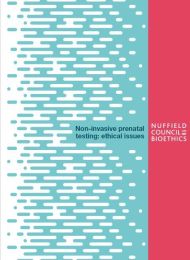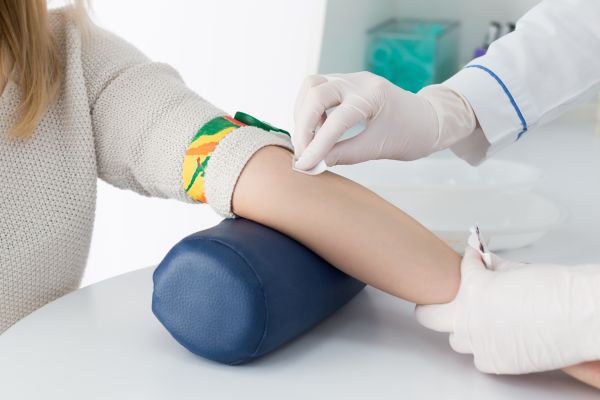Non-invasive prenatal testing: ethical issues
Report
Published 01/03/2017

NIPT in NHS screening for Down’s, Edwards’ and Patau’s syndromes
Down’s, Edwards’ and Patau’s syndromes are examples of ‘aneuploidy’ which is where there is an unusual number of chromosomes in some or all of a person’s cells. This can express itself in a range of ways, including in appearance, physical and intellectual development and health.
Further information about Down’s, Edwards’ and Patau’s Syndromes is available in Chapter 1 of the full report.
Screening for aneuploidies in the NHS
Current NHS policy is to offer all women a prenatal screening test (the ‘combined test’) for Down’s, Edwards’ and Patau’s syndromes between 10 and 14 weeks of pregnancy as part of the NHS fetal anomaly screening programme. Diagnostic testing using CVS or amniocentesis is offered to women who are found through screening to have between a 1 in 2 and a 1 in 150 chance (which is considered a high chance) of having a fetus with one of these syndromes. CVS can be carried out from around 11 weeks of pregnancy, and amniocentesis from around 15 weeks. Approximately 1 in 10 women who get a high chance combined test result will be carrying a fetus with Down’s syndrome; 9 in 10 women will not. Amniocentesis and CVS carry a small risk of miscarriage.
Studies have found that NIPT can give a more accurate prediction of the chance that a fetus has Down’s, Edwards’ or Patau’s syndromes than the combined test alone. NIPT is more accurate in pregnant women who are already known to have at least a 1 in 150 chance of having a fetus with these syndromes, compared to unscreened pregnant women. When NIPT is offered to these higher chance women, as a second stage screening test (ie, following the combined test), 9 in 10 women who receive a high chance NIPT result will have a fetus with Down’s syndrome. This means there is still a small but significant chance a fetus is not affected when a high chance NIPT result is received, and so CVS or amniocentesis should be carried out to get a definitive diagnosis. However, the increased accuracy of NIPT means significantly fewer women will have invasive diagnostic testing.
NIPT has been piloted as a second stage screening test for pregnant women in a number of NHS hospitals. The findings suggest that, if NIPT is offered to all pregnant women in the UK who are found to have at least a 1 in 150 chance of having a fetus with Down’s, Edwards’ or Patau’s syndromes following the combined test, it will lead to:
- Nearly 200 more fetuses with Down’s syndrome identified per year;
- Over 3000 fewer invasive diagnostic tests carried out; and
- An estimated 17 fewer procedure-related miscarriages.
Therefore, offering NIPT as a second stage test for Down’s, Edwards’ and Patau’s syndromes in the NHS would give more women the opportunity to prepare for a disabled child or to choose to have a termination (in England, Wales and Scotland). It would also lower the number of invasive diagnostic tests that are carried out.
The UK National Screening Committee (UKNSC) is the body that advises the UK Government on national screening programmes. Given the benefits of accuracy and safety offered by NIPT, in January 2016, UKNSC recommended an ‘evaluative’ implementation of NIPT for Down’s, Edwards’ and Patau’s syndromes as a second stage screening test in the NHS fetal anomaly screening programme. In November 2016, the Department of Health announced that NIPT will be made available on the NHS, as recommended, from 2018.
Is NIPT an accurate test for Down’s syndrome?
A review of over 40 international research studies has found that when NIPT is used in pregnant women already found, through initial screening, to have a high chance of having a fetus with Down’s syndrome: NIPT will identify 97% of fetuses with Down’s syndrome; 9 in 10 women with a ‘high chance’ result will have a fetus with Down’s syndrome; 1 in 10 will not (a false positive result). NIPT has very few false negative results: almost all women with a ‘low chance’ result will not have a fetus with Down’s syndrome.
Implications
In addition to the benefits offered by NIPT, the people and organisations we spoke to during our project suggested the introduction of NIPT in the NHS screening programme might have a number of consequences that require consideration:
Information and support
- Existing challenges in ensuring women and couples are making informed, autonomous choices about prenatal screening may be intensified by the introduction of NIPT. For example, there are concerns that some healthcare professionals, when imparting information about Down’s syndrome, focus on medical problems, such as heart problems, and learning disability, without describing more fully what it is like to have a child with Down’s syndrome. This may influence the decisions women and couples make. Women and couples’ choices are also influenced by societal attitudes towards disability, the presentation of disability and prenatal testing in the media, and the perceived impact of a disabled child on the family.
- Given the accuracy and non-invasive nature of NIPT, there are concerns that women and couples will think it is equivalent to a diagnostic test, and that it is a ‘routine’ part of prenatal care. Also, women and couples might not appreciate the difficult choices they may be faced with after having NIPT.
Timing and accuracy of diagnosis
- NIPT can fail to produce a result, or the result can be inconclusive. This could prolong the screening pathway for some women and cause anxiety.
- Offering NIPT to women as a second stage test may lead to a delay in diagnosis for some women. Currently women who are found to have a high chance of their fetus having one of the syndromes following the combined test are offered a diagnostic test (CVS or amniocentesis). If these women then take up an offer of NIPT, and subsequently decide to have confirmatory diagnostic testing, there may be a delay of a week or more before a diagnosis is received. This delay may be significant to some women, particularly those considering termination of pregnancy.
Implications for people with genetic conditions
- Introducing NIPT on the NHS is likely to lead to an increase in the number of diagnoses of Down’s, Edwards’ and Patau’s syndromes, and possibly a rise in terminations. If this leads to a significant reduction in the number of babies born with one of these syndromes, it is possible that the specialist health and social care they receive, and the importance attributed to research into these syndromes, will be affected in the future.
- Making NIPT available on the NHS could be perceived as sending negative and hurtful messages about the value of people with the syndromes being tested for.
- Disabled people and their families might be more vulnerable to discrimination, stigma or abuse if NIPT gives rise to perceptions that people are ‘to blame’ for having a baby with a disability.
Implications for NHS and healthcare professionals
Introducing NIPT into the NHS prenatal screening programme may lead to changes in the demand for related NHS services such as genetic counselling, invasive diagnostic testing, termination and laboratory services.
Future uses of NIPT in NHS prenatal screening programmes
It is possible that NIPT for further genetic conditions or impairments could be proposed for inclusion in NHS prenatal screening programmes in the future.
This raises particular issues for the appraisal of screening programmes:
- Although the central aim of prenatal screening is to promote informed choice, there may be unintended consequences for people with the conditions and impairments being screened for and others. This is not currently taken into account in the criteria used by the UKNSC to appraise screening programmes.
- There is a need for more transparency around how screening programmes are appraised, and for improvements in how ethical, social and legal issues are considered in the appraisals.
Find out more in Chapter 2 of the full report.

Share